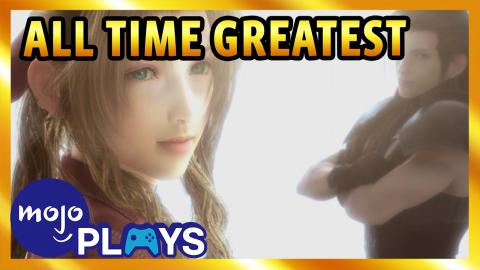Saddest Video Game Death of All Time - Aerith

Check out our Suggestion tool to vote on other Greatest of you'd like to see:
http://WatchMojo.comsuggest/Video+Game+Greatest+of+All+Time+-+Series+
Once upon a time, dying in a video game was just a source of endless frustration . An enemy catching you off guard, a bottomless pit that you couldn’t leap across. Various stage hazards that were difficult to traverse around. Dying meant trying again until you ran out of lives... unless you decided to ragequit. But as video games became more story and character driven, death became more than just an inconvenience. Suddenly, we cared about that character who lost his or her life. Suddenly, there was no way to press the reset button to try and prevent their untimely demise.
After all, we’ve been trying to undo Aerith’s death since 1997.
This is still one of the most talked about deaths in gaming, from how devastating the moment is, to theories on what it was that actually killed her . In case you don’t know the story, here’s a quick rundown without getting too heavy into Final Fantasy 7’s plot: Aerith is trying to stop Sephiroth -- the big bad of the game -- via prayer. As the last in a line of powerful magic users called the Cetra, she’s the only one who can put a stop to his plans. Instead of having a holy figure appear from above, it’s Sephiroth. With a sword. And... yeah, things don’t go well. It leads to what is arguably the most iconic death scene in gaming history.
But what makes it so memorable?
For one thing, there’s the emotional investment with the character. When it comes to the theme of loss in video games, the more attached you are to the deceased, the bigger the impact. This doesn’t have to be someone you love, it can actually be someone you hate, too, as their death will leave you feeling satisfied. But that satisfaction usually fades. Grief, unfortunately, lingers -- not just with the player, but with the characters who are affected by their death. This is something that kept being built on through later installments in the Final Fantasy VII franchise. “Advent Children” shows how everyone is holding up after the events of VII, while “Crisis Core” shows a more detailed look at Aerith’s relationship with Zack. It made the whole event even more tragic, as you soon realize Cloud not only lost his friend, he lost the girl his friend had feelings for, a girl he himself shares a bond with throughout the course of the franchise.
Which brings us to who Aerith was as a character: a sweet flower girl who wasn’t bogged down by the events of the game, even if she was being hunted down by Shinra. Before that, she was a source of comfort for Zack, and much like the Avalanche group in FFVII, she was a source of optimism for him, too. On top of that, she was extremely useful to your party in FFVII, as her healing magic was vital in battle, and apparently, vital to the planet as a whole, as she managed to protect it from Meteor even after death.
Whether she was your favorite or not, the general consensus about her is this: she didn’t deserve to die. Such violent deaths are what we expect for characters like Zack, soldiers of war, but not cute flower girls whose ultimate attack was literally calling on angels from above. Her death was a surprise to us all, not just because of her innocence, but because she was a member of your team. We’ve lost major characters before, and continue to do so in other titles, but there’s a certain formula to how they die. It either happens at the end of the game so you don’t have to figure out what to do without them. It’s someone you can actually save if you play the game correctly, or it’s an NPC you’re really fond of. Aerith defied all of these points. Since she was the healer, leveling her up was important, the stronger she got, the better healing magic she cast. The real kicker? You could actually max her out! While some games have killed off party members before, no one was really expecting it back in 1997.
But at the end of the day, there’s a pretty simple reason why Aerith’s last moments are still gut wrenching to watch: the way the scene is presented to us. Cloud, being controlled by Sephiroth, manages to fight back and not strike the killing blow. It doesn’t matter. She’s killed anyway. Then there’s sound of the beating heart and her theme playing -- even in the battle that follows. And, of course, Cloud laying her to rest in the water. Now we can admit that the graphics of FF7 don’t hold up, but the emotion of the scene still prevails. The lack of voice acting. The harsh schwing of Sephiroth’s sword. Her body falling limp. Her theme playing at just the right time. Her body sinking into the water. And really, that’s all you need to drive the point home. You don’t always need a loud bang into death.Sometimes, it’s the quiet realization that hits the hardest.
It feels a bit weird calling something as tragic as death great, but Aerith’s death really hits all the right notes from a storytelling perspective. It’s sorrowful, but hopeful, in a way, as her presence remains with the planet. It affects the characters and impacts the story just as much as it impacts the player. While it won’t catch anyone off guard today, since it’s common gaming knowledge, there’s still a desire to do as much as we can with Aerith before we lose her. She left her mark on the gaming world, and continues to be the character death which we hail as the greatest of all time.
